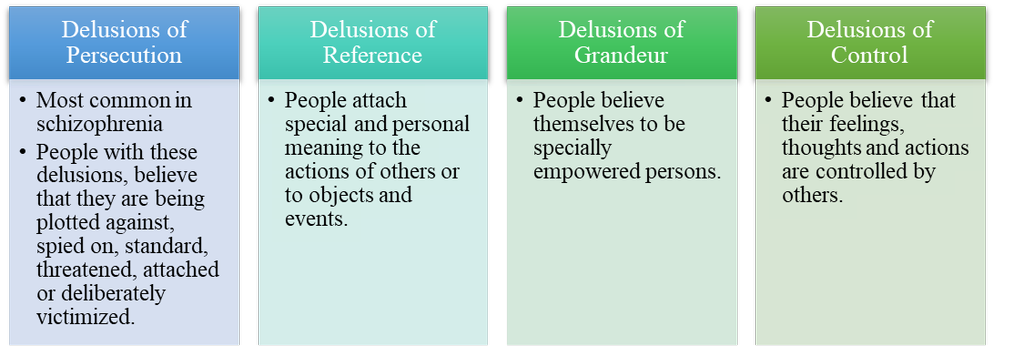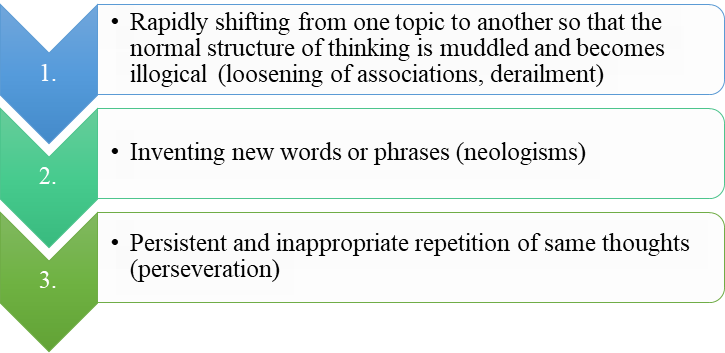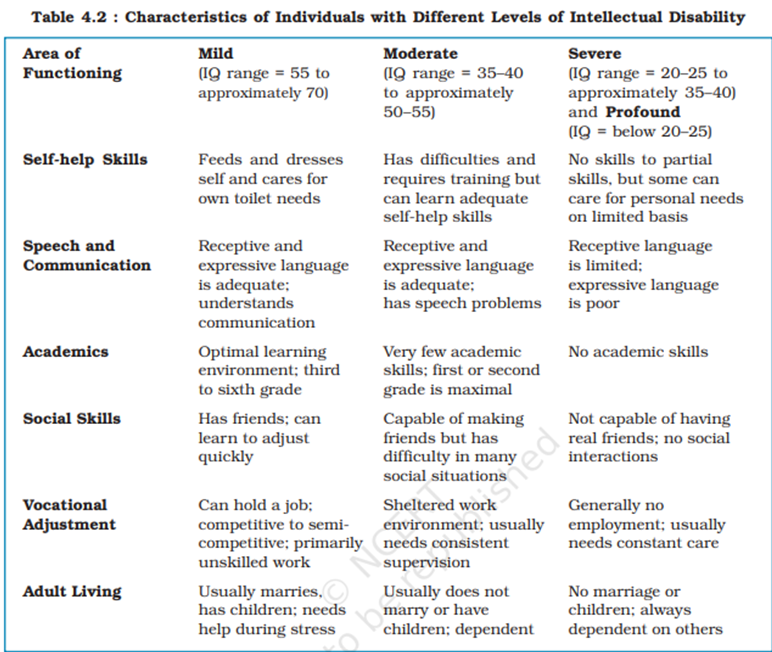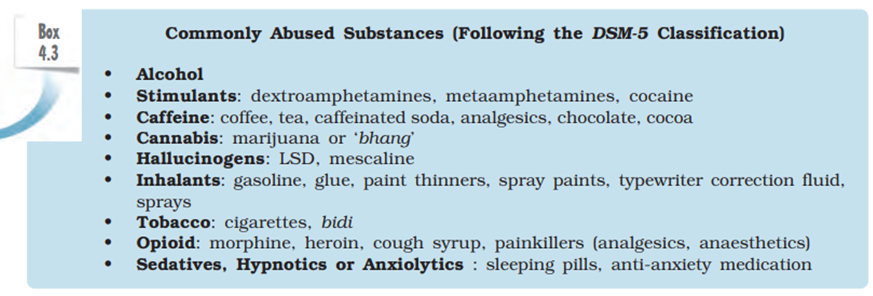- Books Name
- Psychology Book Class-12
- Publication
- PathSet Publications
- Course
- CBSE Class 12
- Subject
- Psychology
Major Psychological Disorders
1) Anxiety Disorders
- High levels of anxiety that are distressing and interfering with effective functioning indicate the presence of an anxiety disorder.
- The term 'anxiety' is usually defined as a diffuse, vague, very unpleasant feeling of fear and apprehension.
- The anxious individual shows combinations of the following symptoms:
- Rapid heart rate
- Shortness of breath
- Diarrhea
- Loss of appetite
- Fainting
- Dizziness
- Sweating
- Sleeplessness
- Frequent urination
- Tremors
a) Generalized Anxiety Disorder
- Consists of prolonged, vague, unexplained and intense fears that are not attached to any particular object.
- Symptoms:
- Worry and apprehensive feelings about the future
- Hypervigilance (involves constantly scanning the environment for dangers)
- Motor tension, as a result of which the person is unable to relax, is restless and visibly shaky and tense.
b) Panic Disorder
- Consists of recurrent/frequent anxiety attacks in which the person experiences intense terror and dread.
- A panic attack denotes an abrupt surge of intense anxiety rising to a peak when thoughts of a particular stimuli are present.
- Such thoughts occur in an unpredictable manner.
- Clinical features:
- Shortness of breath
- Dizziness
- Chest pain or discomfort
- Palpitations
- Fear of going crazy
- Nausea
- Choking
- Losing control
- Dying
- Trembling
c) Phobias
- Irrational fears related to specific objects, people or situations.
- They develop gradually or begin with a generalized anxiety disorder.
- Phobias can be grouped into three main types, i.e. specific phobias, social phobias, and agoraphobia.
(i) Specific Phobias
- Most commonly occurring type of phobia
- Irrational fears such as:
- Intense fear of a certain type of animal
- Being in an enclosed space.
(ii) Social Phobias
- Intense and incapacitating fear and embarrassment when dealing with others.
- Also known as Social Anxiety Disorder
(iii) Agoraphobia
- When people develop a fear of entering unfamiliar situations
- Many agoraphobics are:
- Afraid of leaving their home
- Unable to carry out normal life activities
d) Separation Anxiety Disorders
- Individuals are fearful and anxious about separation from attachment figures to an extent that is developmentally not appropriate.
- Extreme distress when expecting or going through separation from home or other significant people to whom the individual is immensely attached to.
- Children with SAD may have difficulty:
- Being in a room by themselves
- Going to school alone
- Are fearful of entering new situations
- Cling to and shadow their parents’ every move
- To avoid separation, children with SAD may:
- Fuss
- Scream
- Throw severe tantrums
- Make suicidal gestures
e) Other disorders are:
- Selective Mutism
- Substance/Medication Induced Anxiety Disorder
- Anxiety Disorder due to another medical condition
2) Obsessive - Compulsive and Related Disorders
a) Obsessive - Compulsive Disorder (OCD)
- People affected by OCD are unable to control their preoccupation with specific ideas.
- Unable to prevent themselves from repeatedly carrying out a particular act or series of acts that affect their ability to carry out normal activities.
- Obsessive behavior is the inability to stop thinking about a particular idea or topic which the person involved often finds to be unpleasant and shameful.
- Compulsive behavior is the need to perform certain behaviors over and over again.
- Example- counting, ordering, checking, touching, washing.
b) Other disorders are:
- Hoarding disorder
- Trichotillomania (hair-pulling disorder)
- Excoriation (skin-picking disorder)
3) Trauma and stressor related disorders
a) Post-traumatic stress disorder (PTSD)
- People who experience PTSD are often the ones:
- Caught in a natural disaster
- Have been victims of bomb blasts by terrorists
- Been in a serious accident
- Been in a war-related situation
- Symptoms vary widely but may include:
- Recurrent dreams
- Flashbacks
- Impaired concentration
- Emotional numbing
b) Other disorders are:
- Adjustment disorders
- Acute stress disorder
4) Somatic Symptom and Related Disorders
- People experience physical symptoms in the absence of a physical disease.
- The individual has psychological difficulties and complains of physical symptoms, for which there is no biological cause.
a) Somatic Symptom Disorder (presence of physical complaints)
- involves a person having persistent body-related symptoms which may or may not be related to any serious medical condition.
- People with this order tend to be overly preoccupied with their symptoms.
- Continually worry about their health.
- Make frequent visits to doctor
- As a result, they experience significant distress and disturbances in their daily life.
b) Illness Anxiety Disorder (presence of anxiety)
- Involves persistent preoccupation about developing a serious illness and constantly worrying about their possibility
- Accompanied by anxiety about one’s health.
- People with this disorder are overly concerned about undiagnosed disease and negative diagnostic results.
- Do not respond to assurance by doctors
- Are easily alarmed about illness such as on hearing about someone else’s ill-health or some such news.
c) Conversion Disorders
- The symptoms of conversion disorders are the reported loss of part or all of some basic body functions for example:
- Paralysis
- Blindness
- Deafness
- Difficulty in walking
- These symptoms often occur after a stressful experience and may be quite sudden, and have no physical cause.
5) Dissociative Disorders
- Dissociation can be viewed as severance of the connections between ideas and emotions.
- It involves feelings of:
- Unreality
- Depersonalisation
- Estrangement
- Sometimes a loss or shift of identity
- Characteristic:
- Sudden temporary alterations of consciousness that blot out painful experiences.
a) Dissociative Amnesia
- Extensive but selective memory loss that has no known organic cause (example- head injury)
- Some people cannot remember anything about their past
- Others can no longer recall specific events, people, places or objects, while their memory for other events remain intact.
- A part of dissociative amnesia is dissociative fugue.
- Essential features of dissociative fugue are:
- Unexpected travel away from home and workplace
- Assumption of a new identity
- Inability to recall the previous identity
- The fugue usually ends when the person suddenly ‘wakes up’ with no memory of the events that occurred during the fugue.
- This disorder is often associated with an overwhelming stress.
b) Dissociative Identity Disorder (referred to as ‘multiple personality’)
- Most dramatic
- Often associated with traumatic experiences in childhood
- The person assumes alternate personalities that may or may not be aware of each other
c) Depersonalization/Derealization Disorder
- Involves a dream-like state in which the person has a sense of being separated both from self and from reality
- In depersonalization, there is a change of self-perception and the person’s sense of reality is temporarily lost or changed.
6) Depressive Disorders
- Depression is one of the most widely prevalent and recognized of all mental disorders.
- It covers a variety of negative mood and behavioral changes.
- It can be referred to as a symptom as well as a disorder.
a) Major Depressive Disorder
(i) A period of:
- Depressed mood
- Loss of interest or pleasure in most activities
- Change in body weight
- Constant sleep problems
- Tiredness
- Inability to think clearly
- Agitation
- Greatly slowed behavior
- Thoughts of death and suicide
- Excessive guilt
- Feelings of worthlessness
(ii) Factors predisposing towards depression (Risk factors):
- Genetic make-up/ heredity
- Age
- Women during young adulthood
- Men during early middle age
- Gender
- Women are more likely to report a depressive disorder
- Negative life event
- Lack of social support
7) Bipolar And Related Disorders
a) Bipolar I Disorder (earlier referred to as ‘Manic- depressive disorders’)
- Involves mania and depression, which are alternatively present and sometimes interrupted by periods of normal mood.
- Manic episodes rarely appear by themselves; they usually alternate with depression.
b) Other disorders are:
- Bipolar II disorder
- Cyclothymic disorder
Suicide
- Can take place at any point of time of life
- Result of complex interface of biological, genetic, psychological, sociological, cultural and environmental factors.
- Risk factors are:
- Having mental disorders (especially depression and alcohol use disorders)
- Going through natural disasters
- Experiencing violence, abuse or loss
- Isolation at any stage of life
- Previous suicidal attempt (Strongest risk factor)
- Suicidal behavior often indicates difficulties in:
- Problem-solving
- Stress management
- Emotional expression
- Suicidal thoughts lead to suicidal action only when acting on these thoughts seems to be the only way out of a person’s difficulties
- These thoughts are heightened under acute emotional and other distress
- The ramifications of suicide on social circle and communities tend to be devasting and long-lasting.
- The stigma surrounding suicide compel many people, who are contemplating or even attempting suicide, to not seek help thus, preventing timely help from reaching them.
- Therefore, improving identification, referral and management of behavior are crucial for preventing suicide.
- Therefore, we need to:
- Identify the vulnerability
- Comprehend the circumstances leading to such behavior
- Accordingly plan interventions
- Suicides are preventable but there is a need for comprehensive multi-sectoral approach where the government, media and civil society all play important role as stake holders.
- Measures suggested by WHO for preventing suicides are:
- Limiting access to the means of suicide.
- Reporting of suicide by media in a responsible way
- Bringing in alcohol related policies
- Early identification, treatment and care of people at risk
- Training health workers in assessing and managing for suicide
- Care for people who attempted suicide and providing community support.
Identifying Students In Distress
- Any unexpected or striking change affecting the adolescent’s performance, attendance or behavior should be taken seriously, such as:
- Lack of interest in common activities
- Declining grades
- Decreasing effort
- Misbehavior in the classroom
- Mysterious or repeated absence
- Smoking or drinking, or drug misuse.
Strengthening Students’ Self Esteem
- Having a positive self-esteem is important in face of distress and helps in coping adequately.
- In order to foster positive self-esteem in children the following approaches can be useful:
- Accentuating positive life experiences to develop positive identity leading to increased confidence in self.
- Providing opportunities for development of physical, social and vocational skills
- Establishing a trustful communication
- Goals for the students should be specific, measurable, achievable, relevant, to be completed within a relevant time frame.
8) Schizophrenia Spectrum and Other Psychotic Disorders
- Schizophrenia is a descriptive term for a group of psychotic disorders in which personal, social and occupational functioning deteriorate as a result of disturbed thought processes, strange perceptions, unusual emotional states, and motor abnormalities.
- Debilitating disorder
- The social and psychological costs of schizophrenia are tremendous, both to patients as well as to their families and society.
- Symptoms of schizophrenia:
a) Positive symptoms (i.e., excesses of thought, emotion and behavior)
‘Pathological excesses’ or ‘bizarre additions’ to a person’s behavior
Delusions
- A delusion is a false belief that is firmly held on inadequate grounds.
- It is not affected by rational argument.
- It has no basis in reality

Disorganized thinking and speech/ Formal thought disorders
- May not be able to think logically
- May speak in peculiar ways
- Make communication extremely difficult
- Includes:
Heightened perception and Hallucinations
- They are perceptions that occur in the absence of external stimulus.

- Inappropriate affect i.e. emotions that are unsuited to the situation
b) Negative symptoms (i.e. deficits of thought, emotion and behavior)
‘Pathological Deficits’
Alogia or Poverty of speech
- Reduction in speech and speech content
Blunted Affect
- Show less anger, sadness, joy and other feelings than most people do
Flat Affect
- Some show no emotions at all
Avolition/ Apathy (lack of interest, enthusiasm or concern)
- Inability to start or complete a course of action
Social Withdrawal
- May withdraw socially and become tally focused on their own ideas and fantasies
Psychomotor Symptoms
- move less spontaneously
- make odd grimaces and gestures
- may take extreme forms known as catatonia
- People in a catatonic stupor remain motionless and silent for long stretches of time.
- Catatonic rigidity i.e., mainting a rigid, up bright posture for hours.
- Catatonic posturing i.e., assuming awkward, bizarre positions for long periods of time.
9) Neurodevelopmental Disorders
- Common feature - they manifest in the early stage of development
- The symptoms often appear before the child enters school or during the early stage of schooling
- These disorders result in:
- Hampering personal, social, academic and occupational functioning.
- Characteristics:
- Deficits or excesses in a particular behavior
- Delays in achieving a particular age-appropriate behavior
10) Attention Deficit/Hyperactivity Disorder (ADHD)
- If not attended, can lead to more serious and chronic disorders as the child moves into adulthood.
- Main features are:
a) Inattention
- Children find it difficult to sustain mental effort during work or play.
- Have a hard time keeping their minds on any one thing
- Have a hard time in following instructions:
- Common complaints are:
- Child does not listen
- Cannot concentrate
- Does not follow instructions
- Is disorganized
- Easily distracted
- Forgetful
- Does not finish assignments
- Quick to lose interest in boring activities
b) Impulsivity
- Children seem unable to control their immediate reactions
- Unable to think before they act
- Find it difficult to wait or take turns
- Have difficulty resisting immediate temptations or delaying gratification
- Minor mishaps such as knocking things over are common, whereas more serious accidents and injuries can also occur.
c) Hyperactivity
- Children are in constant motion
- Sitting still through a lesson is impossible for them
- Child may fidget, squirm, climb and run around the room aimlessly
- Parents and teachers describe them as ‘driven by a motto’, always on the go, and talk incessantly.
11) Autism Spectrum Disorder (ASD)
- If not attended, can lead to more serious and chronic disorders as the child moves into adulthood.
- Characteristics:
- Widespread impairments in social interaction and communication skills.
- Stereotyped patterns of behaviors, interests and activities.
- Children with ASD have:
- Marked difficulties in social interaction and communication across different contexts
- A restricted range of interests
- Strong desire for routine
- About 70% of children with ASD have intellectual disabilities.
- Children with ASD:
- Experience profound difficulties in relating to other people.
- Are unable to initiate social behavior
- Seem unresponsive to other people’s feelings
- Unable to share experiences or emotions with others
- Show serious abnormalities in communication and language that persist over time
- Many of them never develop speech and those who do, have repetitive and deviant speech patterns
- Show narrow patterns of interests
- Show repetitive behaviors such as lining up objects or stereotyped body movements such as rocking.
- These motor movements may be:
- Self-stimulatory such as hand flapping
- Self-injurious such as banging their heads against the wall.
- Tend to experience difficulties in starting, maintaining and even understanding relationships due to the difficulties in terms of verbal and non-verbal communications.
12) Intellectual Disability
- Refers to below average intellectual functioning (with an IQ of approx 70 or below)
- Deficits or impairments in adaptive behaviors (i.e. in the areas of communication, self-care, home-living, social/interpersonal skills, functional academic skills, work, etc.) which are manifested before the age of 18 years.
- If not attended, can lead to more serious and chronic disorders as the child moves into adulthood.

13) Specific Learning Disorder
- Individual experiences difficulty in perceiving or processing information efficiently and accurately.
- These get manifested during early school years.
- The individual encounters problems in basic skills in reading, writing and mathematics.
- Tends to perform below average for his/her age.
- However, with additional inputs and efforts the individuals may be able to reach acceptable performance levels.
- Likely to impair functioning and performance in activities/occupations dependent on the related skills.
- If not attended, can lead to serious and chronic disorders as the child moves into adulthood.
14) Disruptive, Impulse-Control and Conduct Disorders
a) Oppositional Defiant Disorder (ODD)
- Children display age-inappropriate amounts of stubbornness
- Are irritable, defiant, disobedient
- Behave in a hostile manner
- Do not see themselves as angry, oppositional or defiant and often justify their behavior as reaction to circumstances/demands.
- The symptoms of the disorder become entangled with problematic interactions with others.
b) Conduct Disorder/Antisocial Behaviour
- Refers to age-inappropriate actions and attitudes that violate family expectations, societal norms and personal or property right of others.
- Behaviors typical of conduct disorder include:
- Aggressive actions that cause or threaten harm to people or animals
- Non-aggressive conduct that causes property damage
- Major deceitfulness or theft
- Serious rule violations
- Children show many different types of aggressive behavior such as:
- Verbal aggression (i.e., name-calling, swearing)
- Physical aggression (i.e., hitting, fighting)
- Hostile aggression (i.e., directed at inflicting injury to others)
- Proactive aggression (i.e., dominating and bullying others without provocation)
15) Feeding And Eating Disorders
a) Anorexia Nervosa
- The individual has a distorted body image that leads her/him to see herself/himself as overweight.
- Often refuses to eat
- Exercises compulsively
- Developing unusual habits such as refusing to eat in front of others
- Person may lose large amounts of weight and even starve her/himself to death.
b) Bulimia Nervosa
- The individual may eat excessive amounts of food, then purge her/his body of food by using medicines such as laxatives or diuretics or by vomiting.
- The person often feels disgusted and ashamed when she/he binges and is relieved of tension and negative emotions after purging.
c) Binge Eating
- Frequent episodes of out-of-control eating.
- The individual tends to eat at a higher speed than normal and continues eating till she/he feels uncomfortably full.
- Large amount of food may be eaten even when the person is not feeling hungry.
16) Substance-Related And Addictive Disorders
- Related to maladaptive behaviors resulting from regular and consistent use of the substance involved.
- Includes problems associated with the use and abuse of alcohol, cocaine, tobacco and opiods among others, which alter the way people think, feel and behave.
- Frequently used substances are:
1) Alcohol
- People who abuse alcohol, drink large amounts regularly and rely on it to help them face difficult situations.
- Eventually, the drinking interferes with their social behavior and ability to think and work.
- Their bodies build up to a tolerance for alcohol and they need to drink even greater amounts to feel its effects.
- They also experience withdrawal responses when they stop drinking.
- Alcoholism destroys:
- Millions of families
- Social relationships
- Careers
- Intoxicated drivers are responsible for many road accidents.
- Has serious effects on the children of persons with this disorder as they have higher rates of psychological problems
a) Anxiety
b) Depression
c) Phobias
d) Substance-related disorders
- Excessive drinking can seriously damage physical health.
2) Heroin
- Its intake significantly interferes with social and occupational functioning.
- Most abusers further develop a dependence on heroin, revolving their lives around the substances, building up a tolerance for it and experiencing a withdrawal reaction when they stop taking it.
- Most direct danger of heroin abuse is an overdose, which slows down the respiratory centres in the brain, almost paralyzing breathing, and in many cases causing death.
3) Cocaine
- Regular use of cocaine may lead to a pattern of abuse in which the person may be intoxicated throughout the day and function poorly in social relationships and at work.
- May also cause problems in short-term memory and attention.
- Dependence may develop, so that cocaine dominates the person’s life, more of the drug is needed to get the desired effects, and stopping it results in feeling of
a) Depression
b) Sleep problems
c) Anxiety
d) Fatigue
e) Irritability
- Cocaine poses serious dangers as it has dangerous effects on psychological functioning and physical well-being.


 PathSet Publications
PathSet Publications
